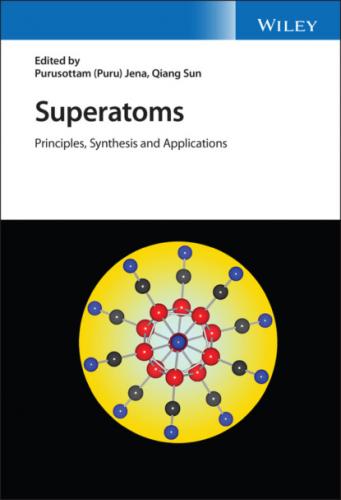If one of the B atoms in B n H n is replaced by a C atom, according to the Wade‐Mingos rule only one extra electron will be needed to satisfy the stability criterion. Hence, CB n − 1H n − should be a stable cluster. Indeed, this is the case and mono‐carboranes with n = 7–12 have been isolated and structurally characterized [77–80]. Pathak et al. [81] hypothesized that CB11H12 should also behave like a halogen atom. Using density functional theory, the authors calculated the structure and found the electron affinity of CB11H12 to be 5.39 eV, establishing it as a superhalogen. They also showed that MB12H12 (M = Li, Na, K, Rb, and Cs) clusters are superhalogens as they only need one electron to satisfy the Wade‐Mingos rule. In addition, they showed that CB11H12 can be used as the building blocks of hyperhalogens.
Figure 2.22 Geometry of B12H122−.
Source: Adapted with permission from Jena and Sun [1]. © American Chemical Society.
Al and B belong to the same column in the periodic table, yet they have different chemistry. While Al is a metal, B is not. In addition, Al is not electron deficient like B and its valence electrons are nearly free in the bulk phase. Al does not form the same range of complexes with H as B does. Consequently, Wade‐Mingos rule was known not to apply to Al. Bowen and coworkers [106] studied the possibility that small clusters of Al may have properties similar to that of B. Using the pulsed arc cluster ion source (PACIS), the authors reacted Al clusters with hydrogen and observed a vast range of previously unknown Al n H m clusters. In Figure 2.23 we show the mass spectra of Al4H m clusters, with Al4H6 being particularly stable. Photoelectron spectroscopy experiment revealed a large HOMO–LUMO gap of 1.9 eV, which further confirmed the unusual stability of Al4H6. To understand the origin of this stability, the authors computed the geometry of Al4H6, which consists of an Al4 tetrahedron with four radially bonded and two bridge‐bonded H atoms. An examination of the electronic structure revealed that two bridge‐bonded H atoms and the four Al‐H pairs contribute 10 electrons. Thus, Al4H6 can be viewed as Al4H4 2−, which satisfies the Wade‐Mingos 2(n + 1) rule with n = 4. Note that n = 6 is the smallest value of n for which B n H n clusters satisfy the Wade‐Mingos rule.
Figure 2.23 PES spectrum of Al4H6 anion (left panel) and mass spectra of Al4Hm−. The inset shows the geometry of Al4H6−.
Source: X. Li et al. [106]. © American Chemical Society.
Wade‐Mingos rule can also be used to rationalize the bonding in Zintl ions, which are multiply charged clusters belonging to the post‐transition metal elements in groups 13, 14, and 15. Consider, for example, Sn12 2−. While studying the semiconductor to metal transition, Wang and coworkers [59] observed a very simple photoelectron spectrum (PES) of Sn12 −, which was different from that of its isoelectronic cousin, Ge12 −. The optimized geometry of Sn12 − was found to be a distorted cage with C5v symmetry. Adding an extra electron resulted in closed shell Sn12 2− cluster with icosahedral (Ih) symmetry (Figure 2.24). The PES of Sn12 2− was found to be similar to that KSn12 −, which can be viewed as K+Sn12 2−. Named stannaspherene, Sn12 2− has a diameter of 6.1 Å, which is large enough to accommodate a metal atom. Indeed, four years prior to the above experiment Kumar and Kawazoe [82] had predicted M@Sn12 (M = Zn, Cd) to be a perfect endohedral cluster with Ih symmetry and a large HOMO–LUMO gap. Cui et al. [83] have subsequently synthesized a series of endohedral clusters with the composition M@Sn12 (M = Ti, V, Cr, Fe, Co, Ni, Cu, Y, Nb, Gd, Hf, Ta, Pt, Au). Kandalam et al. [84] showed that Mn@Sn12 is a stable cluster with a magnetic moment of 5 μB and can be regarded as a magnetic superatom. The bonding pattern of Sn12 2− was found to be similar to that of B12H12 2− where the 12 5s2 localized electron pairs in Sn12 are equivalent to replacing 12 B‐H bonds [59].
Pb12 2−, which is isoelectronic with Sn12 2−, was also found [58] to be a cage cluster whose stability can similarly be justified in terms of the Wade‐Mingos rule. Named “plumbaspherene,” Pb12 2− cage has a diameter of 6.29 Å and can accommodate a metal atom inside it. This is consistent with an earlier experiment where an extremely stable AlPb12 + cluster was synthesized in the gas phase. AlPb12 + can be viewed as Al3 +: Pb12 2− just as KSn12 − was viewed as K+: Sn12 2−. Note that a series of endohedral cage compounds, M@Pb12 2− (M = Ni, Pd, Pt), stabilized by K+ counterions, have been synthesized in solution and in crystalline form. Both of their icosahedral symmetries have been confirmed [85, 86] by X‐ray diffraction and nuclear magnetic resonance (NMR) experiments.
Figure 2.24 Optimized structure of (a) Sn12−, (b) Sn122−, and (c) KSn12−. The bond distances and cage diameters are in angstroms.
Source: Cui et al. [59]. © American Chemical Society.
Zintl compounds composed of alkali and alkaline earth cations and Zintl anions such as Sn5 2−, Pb5 2−, Pb9 4−, Sb7 3−, and Bi4 2− have been known since 1930s [19, 87]. The entry of Zintl ions into cluster science dates back to the work of Recknagel [88],
